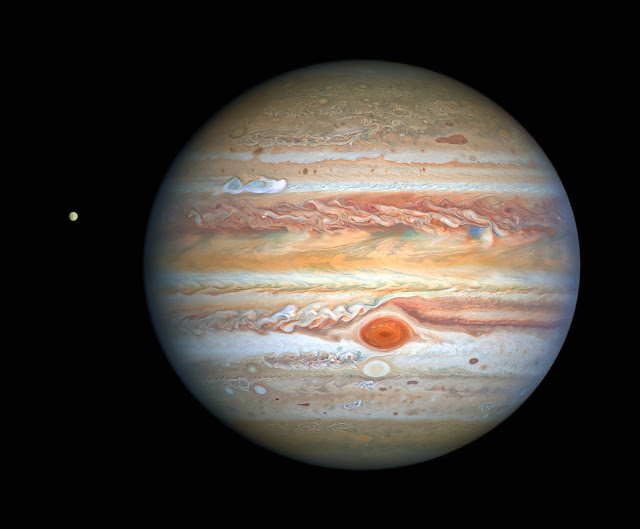We are Going to the Moon! | NASA, ESA and Artemis Partners
This is the Orion spacecraft for the Artemis I mission at NASA's Kennedy Space Center. It was moved from the Launch Abort System Facility to the Vehicle Assembly Building to be stacked atop the Launch Abort System. In that package is the Orion spacecraft which consists of the NASA’s Crew Module, the Crew Module Adapter and the European Space Agency (ESA) European Service Module. Together these modules will power the spacecraft around the Moon and back. Over 30 engines, four solar wings, 8.6 tons of propellant and 11 km of cables are inside. For the first Artemis mission they will work in harmony to travel from Earth to the Moon, make two flybys and return.
For the European Service Module this is just another small step on its way to the Moon. With parts made in ten countries in Europe and assembled in Bremen, Germany, the complete module was flown to Kennedy Space Center at the end of 2018 to be integrated with the crew module.
Launching soon, Artemis I will be a test of the Orion spacecraft and its Space Launch System (SLS) rocket ahead of crewed flights to the Moon.
Through Artemis, NASA aims to land the first woman and first person of color on the Moon, heralding a new era for space exploration and utilization. The NASA-led Artemis program is a new generation of lunar exploration missions designed to send humans farther into space than ever before. The Artemis missions are increasingly complex endeavours that will lay the foundation for sustainable human and robotic exploration of Earth's only natural satellite, the Moon.
While NASA is leading the Artemis missions, international partnerships will play a key role in achieving a sustainable and robust presence on the Moon while preparing to conduct a historic human mission to Mars.
Named after the mythological figure Artemis, who is both Apollo's twin sister and Goddess of the Moon and the hunt, this ambitious campaign encompasses efforts to send the first woman and the next man to walk on the surface of the Moon. These missions will also prepare and propel us onward to Mars. As the "torch bringer," Artemis will light the way for human exploration of the red planet.
Which countries have signed the Artemis Accords?
On May 31, 2021, New Zealand became the 11th country to sign the Artemis Accords. A few days earlier, on May 24, Republic of Korea signed the accords. These two countries join Australia, Canada, Italy, Japan, Luxembourg, the United Kingdom, the United Arab Emirates (UAE), Ukraine, and the United States. (Source: ORF)
With numerous countries and private sector players conducting missions and operations in cislunar space, it is critical to establish a common set of principles to govern the civil exploration and use of outer space.
The Artemis Accords will describe a shared vision for principles, grounded in the Outer Space Treaty of 1967, to create a safe and transparent environment which facilitates exploration, science, and commercial activities for all of humanity to enjoy.
Current Artemis mission plans include:
Artemis I, an uncrewed test flight of the Orion spacecraft, set to launch on the Space Launch System (SLS) rocket in 2022;
Artemis II, the first-ever crewed test flight of the Orion spacecraft, scheduled to launch on the SLS rocket no later than May 2024; and
Artemis III, the mission that will land the first woman and the first person of colour on the Moon, set to launch no earlier than 2025.
Like the Apollo program over 50 years ago, Artemis will begin with missions around the Moon (Artemis I and II) before a mission that lands on the lunar surface (Artemis III).
During later missions, astronauts will dock Orion to the Lunar Gateway, a small space station to which Canada is contributing a smart robotic system, Canadarm3. The Gateway is critical to sustainable lunar exploration and will serve as a model for future missions to Mars. From the Gateway, astronauts will be able to venture to the lunar surface.
In return for contributing Canadarm3, a smart robotic system, to the Lunar Gateway, Canada receives a range of opportunities for lunar science, technology demonstration and commercial activities, as well as two astronaut flights to the Moon. A Canadian Space Agency (CSA) astronaut will be part of Artemis II, the first crewed mission to the Moon since 1972.
Learn more about the NASA Artemis Program:
https://www.nasa.gov/specials/artemis
Caption Credit: NASA, ESA, CSA
Image Credit: NASA–Isaac Watson
Image Date: October 18, 2021
Release Date: February 17, 2022
#NASA #ESA #CSA #Space #Moon #Artemis #Orion #Spacecraft #ServiceModule #SLS #Rocket #Orion #Spacecraft #Mars #JourneyToMars #Science #Engineering #Technology #History #America #UnitedStates #Europe #Canada #International #STEM #Education






